Bonsai Trees
Case Histories
Styrax Japonica - (snowbell)
Styrax Bonsai Style: Informal Upright
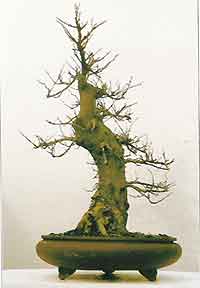
One late spring at a bonsai society meeting I noticed a very eye-catching tree in full flower. On enquiring as to the species I was informed that this bonsai was a styrax. The flowers resembled snowdrops which the owner told me turn into greyish, round berries in the autumn as an added attraction, but on the downside the styrax has a tendency for branches to die back in the winter. Although very attractive in flower, the bonsai was nevertheless poorly designed with a heavily curved 'S' shape trunk.
I decided that my collection was definitely lacking a styrax and that I would search for a suitable specimen. I was always on the lookout for such a tree when visiting bonsai nurseries, but the only styrax bonsai that I ever saw also had ugly, unnatural 'S' shaped trunks.
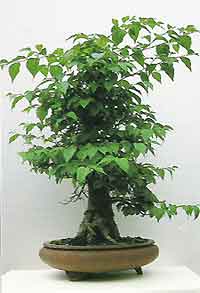
I was talking to a bonsai friend later that year about my search for a good styrax. He told me that he knew of a bonsai nursery that was importing two very large potential specimen trees of this species that spring. One had a hollow trunk and he had selected that for himself. The other tree of equal quality could be saved for me on a first refusal basis. I jumped at this opportunity and eagerly awaited their arrival during the winter.
The phone call came to say that our trees were waiting at the bonsai nursery for our inspection! We drove up together the next day and made sure that there was plenty of room in the back of the car for our trees, should we decide to buy them. When I first saw these styrax bonsai I was amazed at the size of the trunks. I had never seen styrax that were so big and was told by the nursery owner that being this large, they were two very unusual trees.
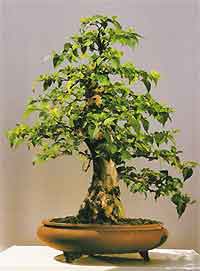
My friend's tree was the smaller of the two and its main attraction was a beautifully carved trunk and well developed branches. My tree was completely different, being much larger and with a poorer branch structure. This did not deter me as I wanted to design my own tree around its powerful trunk.
That afternoon we set off on our journey home, heavily laden with bags of akadama, our styrax trees and also several other bonsai that we'd selected during our visit (we had struck a very good deal!) I was very excited and eagerly anticipated late spring when the tree would hopefully be laden with flowers!
Styrax Bonsai History: Training
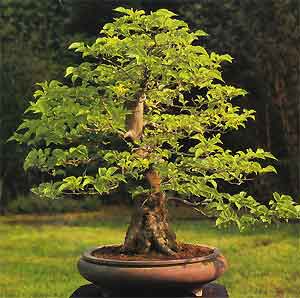
At the weekend I decided to repot the tree as it was clearly pot bound, and also to change the front to a more pleasing angle. The soil still contained clay from the field where it had spent its early years and this was removed. The pot was very in-curved and I was dismayed to see that the inside was flaking badly, making the sides of the pot very thin in places.
Car filler was applied to strengthen the pot and when this had dried I completed the repotting process, returning the styrax to my cold greenhouse to give it good winter protection. When placing it on the bench one of the feet fell off the bottom of the pot! Worse still, when the tree began to grow it became clear that over half of the branches were completely dead!
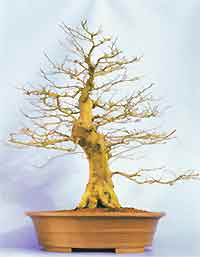
I was not too concerned about the pot and glued the foot back on - another pot could always be found. I was however worried about this unique tree and anxiously waited to see how or if it would recover. In a matter of weeks new shoots had appeared at the bases of the dead branches and so, as the temperature was now warmer, the bonsai with its fresh new leaves was moved to a sheltered site outside.
I was horrified the next day when I noticed that it had dropped a large number of leaves and thought that it must have been the shock of moving it, even though it was very mild by now. More leaves continued to fall for the next few weeks before the tree started to recover. When I was happy that the tree was growing strongly and that no flowers were going to appear, I pruned, wired and set in place a basic branch structure.
After good winter protection, I decided to leave the tree in the greenhouse for longer this spring, so that it would be stronger before moving it outside. When it was in full leaf and growing well the styrax was situated in the most sheltered area in the garden, but as before it proceeded to drop many leaves.
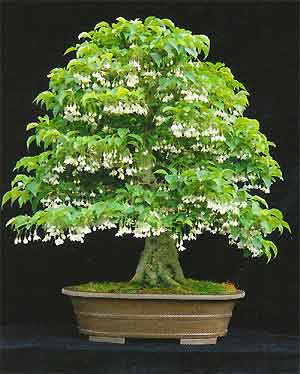
A couple of small branches had also died and were beginning to re-shoot at the base. This was obviously a fussy tree, but I was in no doubt that it would be worth all the trouble, anticipating flowers that year. Unfortunately no flowers came, although the tree continued to grow well. My friend's styrax also had yet to flower and so that was reassuring!
The next year I thought it prudent to let the styrax leaf out on the bonsai bench outside, moving it into the shed any night that frost was forecast. The tree seemed much stronger when the leaves arrived, and not one fell off! I think that I had been cosseting this tree too much. A major branch had died during the winter, but again there was a young shoot nearby to replace it.
The bonsai was looking healthier than it ever had and then to my delight, it flowered for the first time, with almost one hundred white, bell shaped flowers. What a joy! I was confident that the tree would flower well from now on, but that was not the case. One year later, and although still in good health, only three flowers appeared! Maybe the tree was growing too well at the expense of flowers.
On a regular visit to a local bonsai nursery to stock up on spring supplies I noticed a wonderful, large, oval pot at the top of a bonsai pot display. I commented to my wife that it would suit the styrax, and as that morning another foot had fallen off the existing pot, I decided that the bonsai had reached a stage where it really deserved a better, larger pot. With this new pot giving greater room for root development, the frustrating problem of shedding branches during the winter might be resolved. I am convinced that the small pot was the cause and that the tree will now be much happier with more room for root growth. Immediately upon my arrival home the styrax was repotted and the transformation was tremendous.
 One late spring at a bonsai society meeting I noticed a very eye-catching tree in full flower. On enquiring as to the species I was informed that this bonsai was a styrax. The flowers resembled snowdrops which the owner told me turn into greyish, round berries in the autumn as an added attraction, but on the downside the styrax has a tendency for branches to die back in the winter. Although very attractive in flower, the bonsai was nevertheless poorly designed with a heavily curved 'S' shape trunk.
One late spring at a bonsai society meeting I noticed a very eye-catching tree in full flower. On enquiring as to the species I was informed that this bonsai was a styrax. The flowers resembled snowdrops which the owner told me turn into greyish, round berries in the autumn as an added attraction, but on the downside the styrax has a tendency for branches to die back in the winter. Although very attractive in flower, the bonsai was nevertheless poorly designed with a heavily curved 'S' shape trunk. I was talking to a bonsai friend later that year about my search for a good styrax. He told me that he knew of a bonsai nursery that was importing two very large potential specimen trees of this species that spring. One had a hollow trunk and he had selected that for himself. The other tree of equal quality could be saved for me on a first refusal basis. I jumped at this opportunity and eagerly awaited their arrival during the winter.
I was talking to a bonsai friend later that year about my search for a good styrax. He told me that he knew of a bonsai nursery that was importing two very large potential specimen trees of this species that spring. One had a hollow trunk and he had selected that for himself. The other tree of equal quality could be saved for me on a first refusal basis. I jumped at this opportunity and eagerly awaited their arrival during the winter. My friend's tree was the smaller of the two and its main attraction was a beautifully carved trunk and well developed branches. My tree was completely different, being much larger and with a poorer branch structure. This did not deter me as I wanted to design my own tree around its powerful trunk.
My friend's tree was the smaller of the two and its main attraction was a beautifully carved trunk and well developed branches. My tree was completely different, being much larger and with a poorer branch structure. This did not deter me as I wanted to design my own tree around its powerful trunk. At the weekend I decided to repot the tree as it was clearly pot bound, and also to change the front to a more pleasing angle. The soil still contained clay from the field where it had spent its early years and this was removed. The pot was very in-curved and I was dismayed to see that the inside was flaking badly, making the sides of the pot very thin in places.
At the weekend I decided to repot the tree as it was clearly pot bound, and also to change the front to a more pleasing angle. The soil still contained clay from the field where it had spent its early years and this was removed. The pot was very in-curved and I was dismayed to see that the inside was flaking badly, making the sides of the pot very thin in places. I was not too concerned about the pot and glued the foot back on - another pot could always be found. I was however worried about this unique tree and anxiously waited to see how or if it would recover. In a matter of weeks new shoots had appeared at the bases of the dead branches and so, as the temperature was now warmer, the bonsai with its fresh new leaves was moved to a sheltered site outside.
I was not too concerned about the pot and glued the foot back on - another pot could always be found. I was however worried about this unique tree and anxiously waited to see how or if it would recover. In a matter of weeks new shoots had appeared at the bases of the dead branches and so, as the temperature was now warmer, the bonsai with its fresh new leaves was moved to a sheltered site outside. A couple of small branches had also died and were beginning to re-shoot at the base. This was obviously a fussy tree, but I was in no doubt that it would be worth all the trouble, anticipating flowers that year. Unfortunately no flowers came, although the tree continued to grow well. My friend's styrax also had yet to flower and so that was reassuring!
A couple of small branches had also died and were beginning to re-shoot at the base. This was obviously a fussy tree, but I was in no doubt that it would be worth all the trouble, anticipating flowers that year. Unfortunately no flowers came, although the tree continued to grow well. My friend's styrax also had yet to flower and so that was reassuring!